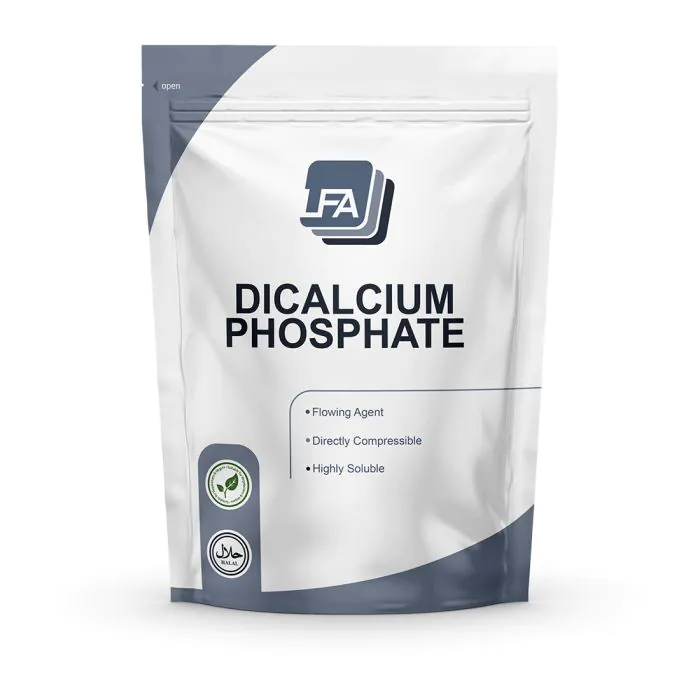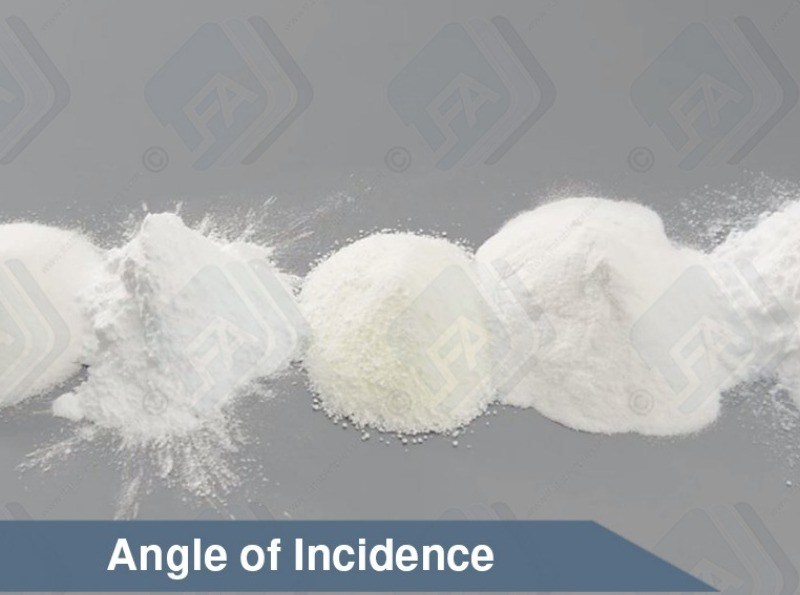Le Phosphate dicalcique est un ingrédient dans une variété de différents produits. Il est utilisé dans la production de comprimés et gélules comme un « agent fluide ». Le Phosphate dicalcique est disponible en différentes tailles de maillage. Les grades plus grossiers fournis ici sont bien fluides et ont une excellente compressibilité.
La fluidité est un élément crucial dans le processus de fabrication. Elle assure que vos ingrédients passeront à travers la machinerie avec aisance. De plus, cela signifie que vos produits finis auront des ingrédients répartis uniformément. Cela assurera que chaque comprimé sera le même.
La compressibilité est l’aisance lors de laquelle une poudre se forme dans un comprimé solide. Le Phosphate dicalcique de LFA est directement compressible. L’utilisation des excipients comme le Phosphate dicalcique réduit l’effort requis pour créer de nouvelles formules.
Le Phosphate dicalcique est grandement soluble en acide citrique et en citrate d’ammonium. Il a un ph de 6.5 à 7. A cause de son alcalinité, il ne fonctionnera pas avec des ingrédients actifs acides. Les propriétés liantes du Phosphate dicalcique sont seulement modérées. Il sera aux côtés d’autres excipients.
Le Phosphate dicalcique passera facilement au travers du système digestif. Il a de nombreuses utilisations, et est un complément alimentaire à lui tout seul. Il est souvent inclus dans des produits de céréales de petit-déjeuner, farine et nouilles. Il est utilisé en tant qu’agent antiagglomérant du fait qu’il puisse absorber des faibles quantités d’humidité. Il est également une source minérale de phosphate qui est souvent utilisée dans des aliments biologiques. Une autre utilisation importante pour le Phosphate dicalcique est dans l’alimentation pour les animaux. Il contribue au métabolisme des animaux et accélère leur croissance et développement.
Manipuler correctement le Phosphate dicalcique est important pour la sécurité et la qualité du produit. Ce produit peut irriter les yeux et l’inhalation peut causer un léger inconfort à la poitrine. Lors de la manipulation, vous devez utiliser des lunettes de protection, des gants et un masque d’inhalation. Stockez toujours le Phosphate dicalcique dans un récipient scellé à des températures modérées. Evitez l’exposition à l’humidité et à des températures extrêmes. Un stockage inapproprié peut affecter la dureté du comprimé avec le temps.
Le Phosphate dicalcique est un agent fluide efficace qui contribuera aux nutriments de votre formule. Il peut être ajouté à beaucoup d’aliments comme un complément pour contribuer aussi bien au bien-être des humains qu’aux animaux. Le Phosphate et le Calcium pour le régime alimentaire des consommateurs amélioreront des fonctions corporelles de nombreuses façons. C’est un produit avec lequel les consommateurs sont familiers et l’addition parfaite à votre comprimé.
Le Phosphate dicalcique de LFA est livré en poudre cristalline. Il sera blanc ou blanc cassé, inodore et fluide.
Rédigez votre propre commentaire
Are all excipients safe for all ages to consume?
Yes, it does not matter what age, size or sex the person consuming the products is. It is, however, important to check the intolerance data.
Are all the excipients safe for human consumption?
Yes, all of the excipients are safe for human or animal consumption. There are some precautions that should be taken when handling them and there are some people that might have intolerances to some of them. Information on this can be found in the products MSDS and Intolerance Data Sheet. This can be found in this section for every excipient.
Are there any known allergens or health risks?
Sont votre Excipients naturels?
Oui, tous nos Excipients sont extraits de sources naturelles. Pour plus d'informations, veuillez visiter les pages produits.
Can I get a better price for excipients than is listed on the website?
Yes, we have bulk pricing for all of our excipients, and these can be found in this section. We offer bulk in 500 kg, 1 ton, 2 ton and 5 ton lots. The prices are set on these quantities as these are the amounts that will fit on pallets.
Can I have a CoA for my Excipient?
Yes. CoA stands for Certificate of Analysis this is also known some times as an MSDS (Material Safety Data Sheet) all of the information contained in a CoA is inside the MSDS for every LFA product which is emailed to you after purchase.
Puis-je produire des comprimés sans Excipients?
Il est peu probable que vous serez en mesure de produire des comprimés sans l'aide des Excipients à tous. Certains produits ne se lient sans Excipients, mais alors ne pas s'écouler à travers la machine. Nous vous conseillons d'utiliser un
Dissolving rate? Any known factors that can affect the rate, speed up or slow down the breakdown of a tablet?
Yes. There are two things at play here. You can get hygroscopic and hydrophobic excipients. Hygroscopic means that they take on water quickly, while hydrophobic means that they repel water.
There are products know as supper disintegrants. These products help the breakdown of tablets. At the moment LFA does not sell any supper disintegrants.
Magnesium stearate is hydrophobic this means that it will slow the breakdown of a tablet.
However, it is used in such small amounts that most of the time it will not make a difference to our customer's products. If they would like to be sure then they should conduct what is known as a disintegration test.
Do any of the excipients increase the speed of damage to tooling? i.e. more granular?
Yes, Dicalcium Phosphate, if used in high amounts, will cause more damage to tooling than just Firmapress or MCC. However, there are not many situations in which this would be a good idea.
How long is the storage period of each excipient? What is the shelf life?
Firmapress - 2 years form batch date.
Dextrose - 3 years from batch date.
Dicalcium Phosphate - 3 years from batch date.
Microcrystalline Cellulose -
Magnesium stearate -
Lactose - 2 years from batch date.
Silica Dioxide - 2 years from batch date.
How should I clean contact parts that have come into contact with my excipients or active ingredients?
here are 6 steps that should be followed as a general rule of thumb when cleaning contact surfaces that have come into contact with powders:
Dry Clean - First you need to remove as much of the dry powder as possible. You can do this using a hover/vacuum. Make sure that the vacuum you are using has a filter good enough to handle fine dust.
Wet Clean - Next you need to perform a wet clean. This can be done with warm water and soap or if available an ultrasonic cleaner.
Rinse - Next you need to rinse off any soap with potable water (drinking water). You do not have to do this if you used an ultrasonic cleaner in the last step. It is important to ensure that all parts are thoroughly dried immediately after washing to avoid any rusting.
Sanitise - Next you need to sanitise the surface. This step is recommended by the FDA. There are a number of sanitising solutions available designed to be applied and left on.
Lubricate - You now need to lubricate any parts that require it. This should be with the appropriate grade oil or grease considering your use and greasing chart. Store - Finally store any of the parts in a cool dry place. If you are storing them on the machine then make sure the machine is in a temperature controlled environment with low humidity.
Quelle est la différence entre la gamme des excipients?
Nous vous proposons de la Cellulose Microcristalline, Stéarate de Magnésium, le Phosphate Dicalcique et Firmapress dans notre gamme des excipients.
La Cellulose microcristalline est un agent de liaison, qui renferme le contenu de la tablette.
Le Phosphate dicalcique est un écoulement de l'agent et contribue à déplacer les ingrédients dans la machine avant qu'ils sont compressés.
Le Stéarate de magnésium est un lubrifiant sec et aide à nouveau avec le mouvement des ingrédients dans la machine, mais contribue également à l'éjection de la tablette de la machine. Veuillez noter que le Magnésium Sterate ne se lie pas par lui-même.
Firmapress est un tout en un mélange de Cellulose Microcristalline, Stéarate de Magnésium et Phosphate Dicalcique.
What is the mesh size of your excipients? etc.
Dextrose - approx 100 mesh
Dicalcium Phosphate - approx 100 mesh
Microcrystoline Cellulose - approx 120-200
Magnesium sterate -
Lactose - 80 mesh
Silica Dioxide -
Firmapress - 100-200 mesh
What kind of agent is each excipient?/ What is the main use of each excipient?
Dextrose - Sweetener, binding agent, good for chewable tablets or candy.
Microcrystalline Cellulose - Binder, filling agent. Good at binding tablets and making them bigger. It can also be used as a filler for capsules.
Magnesium stearate - Dry Lubricant. This stops products from getting stuck to the tooling. It can also help with powder flow issues and caking issues.
Lactose - Binder, sweetener and bulking agent. It has a large mesh so it flows well but most people do not like it because of the intolerance issues.
Silica Dioxide - Flowing agent. This assist powders in flowing smoothly through the machines. It also helps with cacking issues where powders get stuck to the machine.
What kind of condition should excipients be stored in?
Firmapress - 2 years form batch date.
Dextrose - 3 years from batch date.
Dicalcium Phosphate - 3 years from batch date.
Microcrystalline Cellulose -
Magnesium stearate -
Lactose - 2 years from batch date.
Silica Dioxide - 2 years from batch date.
Which excipient should I add if the product doesn't bind well?
If your product does not bind well then we would recommend using MCC. This can be used in any % the limiting factor is the size of the tablet.
If the amount of MCC you would have to use would be too much or if you do not want to use MCC then you have 3 other options: Ask your supplier for a directly compressible or tabletable grade of your product. Spray dry your product. Wet granulate your product.
Which excipient should I add if the product is sticky?
If your product is sticky then you will need to add a dry lubricant to your mix. For this, we recommend magnesium stearate.
We do not recommend that you add more than 1% to the mix as more than this can cause capping. If your product is still sticky at this point then we would recommend looking into granulation.
Which excipient should I add if the product/API is clumpy?
If your product or API is clumpy then you will need to add an anticaking agent. For this, we recommend silicon dioxide. We only recommend adding a maximum of 2% of this to the mix








